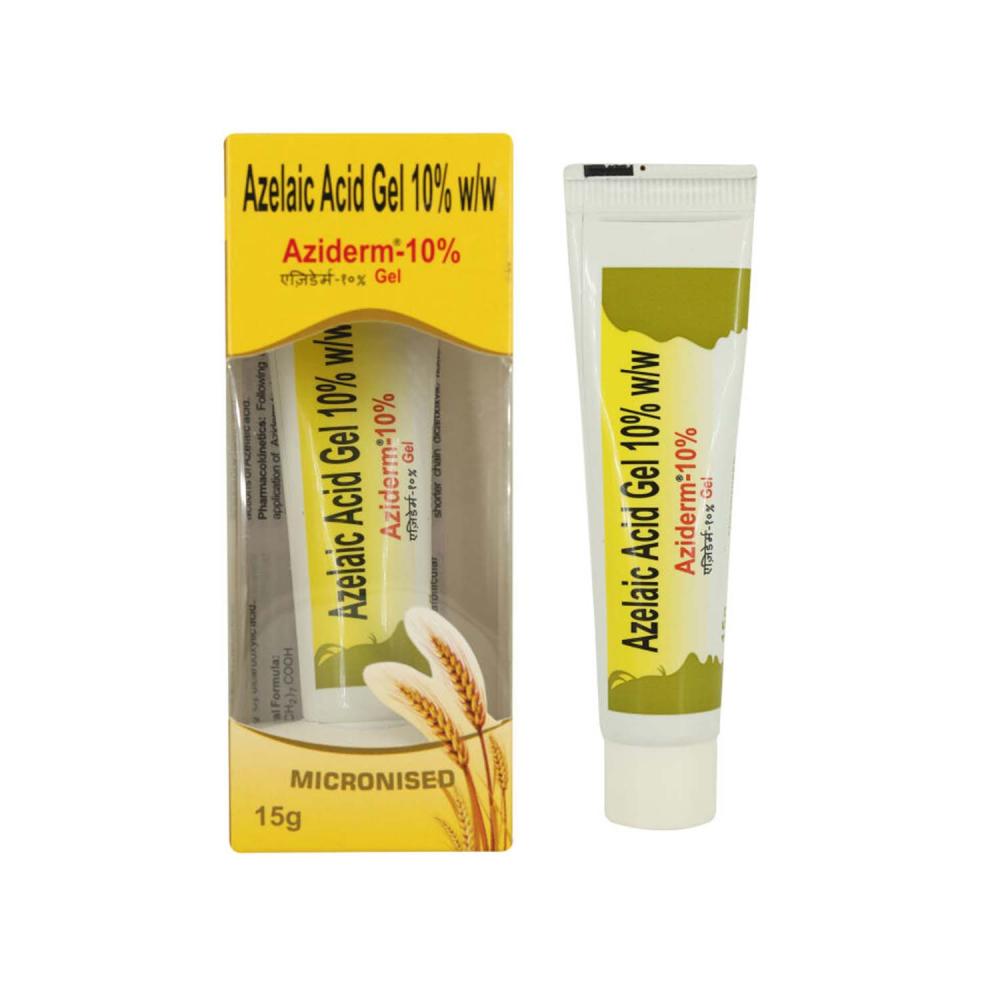
Aziderm 10% Gel Guide: Acne Control, Pigmentation & Redness Relief
Aziderm 10% Gel has become a well-known skincare treatment among people dealing with acne, pigmentation, and persistent redness. With azelaic acid as its active ingredient, this Aziderm 10% Gel is often recommended by dermatologists for its gentle yet effective approach to improving overall skin clarity. This guide explores the product from a third-person perspective, examining its benefits, ingredients, user experience, safety, and how it fits into different skincare routines.
What Makes Aziderm 10% Gel Effective?
Aziderm 10% Gel works because of its primary ingredient—azelaic acid. This compound is naturally found in grains and is known for its anti-inflammatory, antibacterial, and exfoliating properties. Unlike harsh acne treatments, azelaic acid offers a balanced solution that treats multiple concerns at once, making Aziderm a popular choice.
Many users prefer this gel because it can address acne, pigmentation, and texture irregularities without causing excessive dryness. Its versatility makes it suitable for beginners as well as those with sensitive or reactive skin.
Key Ingredient: Azelaic Acid 10%
The star component of Aziderm is 10% azelaic acid, a dermatologist-approved ingredient widely used for:
-
Treating mild to moderate acne
-
Reducing pigmentation and melasma
-
Helping fade acne marks
-
Soothing skin redness and irritation
-
Improving overall texture
At 10%, the concentration is strong enough to deliver visible results while remaining gentle enough for daily use in many skin types.
Skin Benefits of Aziderm 10% Gel
Aziderm provides several benefits, especially for those dealing with acne-prone or uneven skin. Some of the most notable advantages include:
1. Acne Control
Azelaic acid helps reduce the growth of acne-causing bacteria while keeping pores clear. It works well for whiteheads, blackheads, and mild inflammatory acne. Users often notice fewer breakouts after consistent use.
2. Reducing Dark Spots & Acne Marks
One of the reasons Aziderm is widely trusted is its ability to fade pigmentation. It gradually reduces post-acne marks, sun-induced spots, and uneven tone. With steady use, the skin begins to look more uniform and brighter.
3. Soothing Redness & Sensitivity
Aziderm is helpful for people experiencing skin redness or inflammation. The gel calms irritation and helps regulate skin sensitivity without being too harsh, making it suitable for those with rosacea-like symptoms.
4. Improving Texture & Smoothness
Regular use helps gently exfoliate dead skin cells. As a result, the skin becomes softer, smoother, and more refined over time.
How to Use Aziderm 10% Gel Properly
To get the best results, Aziderm should be used correctly. A simple and safe routine includes:
Step-by-Step Application
-
Cleanse with a mild, non-irritating face wash
-
Pat dry — do not apply on damp skin
-
Apply a pea-sized amount of Aziderm to affected areas
-
Wait a few minutes before layering moisturizer
-
Use sunscreen every morning
Frequency
-
New users: Start with once every other night
-
After adjustment: Use once or twice daily as tolerated
Important Tips
-
Avoid mixing with strong exfoliants (AHA/BHA)
-
Introduce slowly to avoid irritation
-
Use consistently for several weeks to see full results
Who Should Use Aziderm 10% Gel?
Aziderm is suitable for a wide range of skin types and concerns.
Ideal For:
-
Oily or acne-prone skin
-
Individuals with dark spots or post-acne marks
-
People experiencing mild redness or irritation
-
Those with uneven texture
Not Recommended For:
-
Extremely dry or damaged skin (unless paired with a rich moisturizer)
-
People allergic to azelaic acid
-
Users seeking instant results rather than gradual improvement
User Experience: What People Often Report
From a third-person review perspective, the general user experience with Aziderm is positive. Most individuals notice:
-
Gradual but visible reduction in new acne
-
Softening of dark spots over time
-
Reduced redness and irritation
-
Improved skin texture
Some users appreciate that the gel feels lightweight and does not clog pores. However, like any active ingredient, the experience can vary.
Possible Side Effects
While azelaic acid is considered gentle, mild reactions may occur, especially during the first week. These include:
-
Slight tingling
-
Redness
-
Mild peeling
-
Dryness
These side effects usually settle when the skin adjusts. Using moisturizer can help reduce irritation. If symptoms worsen or last longer than expected, it’s best to pause usage and consult a professional.
How Long Does It Take to See Results?
Aziderm is not a quick-fix product. Most users begin to see initial improvements in:
-
Redness: 1–2 weeks
-
Acne reduction: 3–4 weeks
-
Pigmentation fading: 6–8 weeks
-
Texture improvement: ongoing with consistent use
The best results usually appear around the 8–12 week mark.
Final Thoughts
Aziderm 10% Gel is a reliable choice for anyone looking for a non-irritating yet effective treatment for acne, pigmentation, and redness. Its gentle formula suits beginners, while its results make it a valuable long-term addition to skincare routines. With consistency, patience, and proper sunscreen use, users can expect clearer, calmer, and more even-toned skin.
If you want to explore more effective skincare options, you can always discover premium beauty products from trusted sources online.
